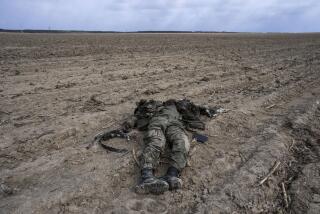Secrecy Shrouds Extent of Loss
- Share via
WASHINGTON — More than six days after an explosion and fire heralded what experts call history’s worst nuclear-reactor accident, not even top Western officials are prepared to say for sure whether the Chernobyl disaster has killed two people or 2,000, whether it contaminated a few acres or thousands of square miles, or even whether major cities such as Kiev are seriously threatened by radioactive air and water.
Stymied by a Soviet cloak of secrecy, American experts said Thursday that they can only guess at the extent of damage caused by the Ukrainian incident. Piecing together scanty and sometimes misleading data, satellite photos and tourists’ accounts, however, they are beginning to construct worst-case and best-case assessments of the accident’s probable impact.
The emerging assessments, which will be refined in the days ahead as detailed studies of European fallout and other data enable scientists to calculate backward to the scene at Chernobyl itself, point toward a middle-ground view of the accident’s impact.
Best-Case Assessments
Even the best-case assessments are less sanguine than the Soviets’ claim of minimal damage--only two dead, 197 injured and no widespread radioactive contamination. At the same time, Western analysts say the worst-case projections may not be as bad as some based on speculation immediately after the disaster.
That no one outside the Soviet bureaucracy knows for certain is underlined by the conflicts in the experts’ own views.
“Our best information from intelligence sources . . . is that we don’t have any information that disproves what the Soviet estimate is,” said Bill Gunter, an Environmental Protection Agency radiation expert on a federal task force monitoring the Soviet disaster.
But a very knowledgeable government official who insisted on anonymity saw matters differently. “We know a lot of people were killed in the immediate explosion, after the fire,” he said, “but we don’t know how many. Four is certainly absurd, but 2,000 may be absurd, too.
“Nobody has any hard figures.”
If Soviet secrecy has left the West awash in speculation, this much appears certain: The huge blast and subsequent fire at Chernobyl killed some people instantly and very likely caused heavy radioactive contamination in an area stretching at least a few miles around the plant.
Most experts contacted by The Times are convinced that the contamination will be long-lasting, because some of the radioisotopes released in the blast take decades to decay into harmless elements. But speculation that the disaster killed 2,000 and flooded hospitals in Kiev and Moscow with radiation victims is, so far, just speculation.
A Swedish scientist using fallout data collected in that country told the New York Times on Wednesday that an area within six miles of the Chernobyl plant likely has been rendered uninhabitable for decades. Stanley Auerbach, director of environmental sciences at the Oak Ridge (Tenn.) National Laboratory, a federally funded nuclear research center, on Thursday called that estimate “plausible” but declined to endorse it directly.
Auerbach is one of several scientists who documented a 1957 nuclear disaster in the Soviet Union’s southern Ural Mountains region--a disaster Soviet authorities indirectly conceded only this week when they called the Chernobyl accident the first in 30 years.
“It obviously has released a lot of radioactivity. We know that because of the fallout in Sweden and Finland, 750 miles away,” Auerbach said. “But the question of what’s going to be contaminated around the plant depends a lot on local meteorological conditions and the magnitude of the explosion that took place there--whether it spewed a lot of stuff into the air. And we don’t have a good handle on that.”
For example, he said, a huge explosion could pour huge quantities of contamination into the atmosphere but a less catastrophic outcome is also possible. Because the fire involved graphite, a relatively pure form of carbon, a fire such as the one at the Soviet reactor might emit only tiny, light carbon particles that would float into the upper atmosphere and disperse, not fall to earth nearby.
The same lack of data makes it equally tough to estimate long-term radioactive damage from the cloud that drifted over parts of the Ukraine’s rich farmland, where much of the Soviet Union’s grain is grown, said Anthony P. Malinauskas, director of Nuclear Regulatory Commission programs at Oak Ridge.
Farming Patterns
“In principle,” he said, “we can back-calculate what was released in the accident, knowing weather patterns and the concentrations of radioactivity and the various radionuclides that have been determined in Sweden. To my knowledge, however, no one has made that calculation.
“The problem has been the information that we have been getting--everything is secondhand and thirdhand. Clearly, some of the information I am getting is inaccurate.”
Widespread dusting of farmlands with fallout could prove catastrophic, because vast quantities of radioactive topsoil would have to be scraped up and trucked away for safe disposal. Further, spring rains could carry “hot” soil into local streams and even into underground water tables, where it would be virtually impossible to clean up.
But such damage probably will not be evident for months--until farming patterns can be viewed from satellite photographs, said the government source close to the Ukrainian situation.
More to Read
Sign up for Essential California
The most important California stories and recommendations in your inbox every morning.
You may occasionally receive promotional content from the Los Angeles Times.













